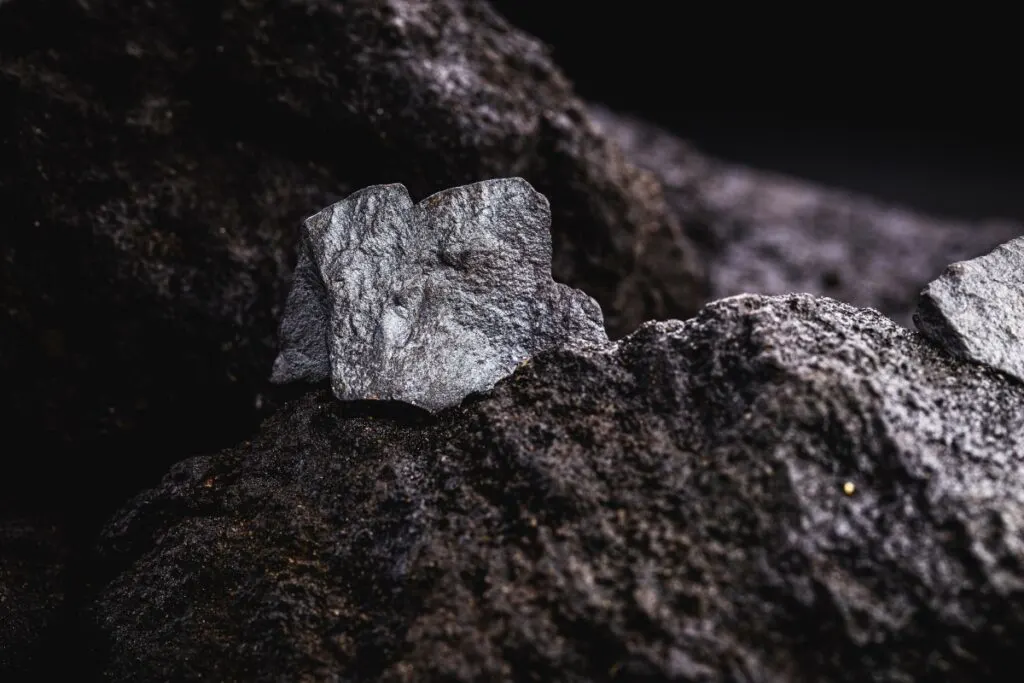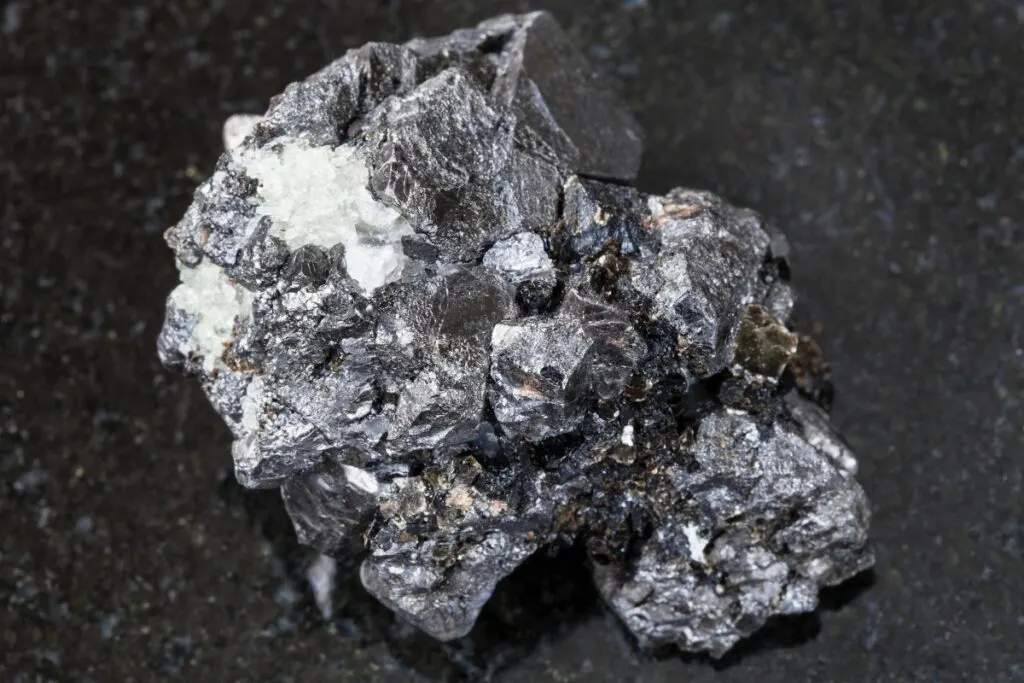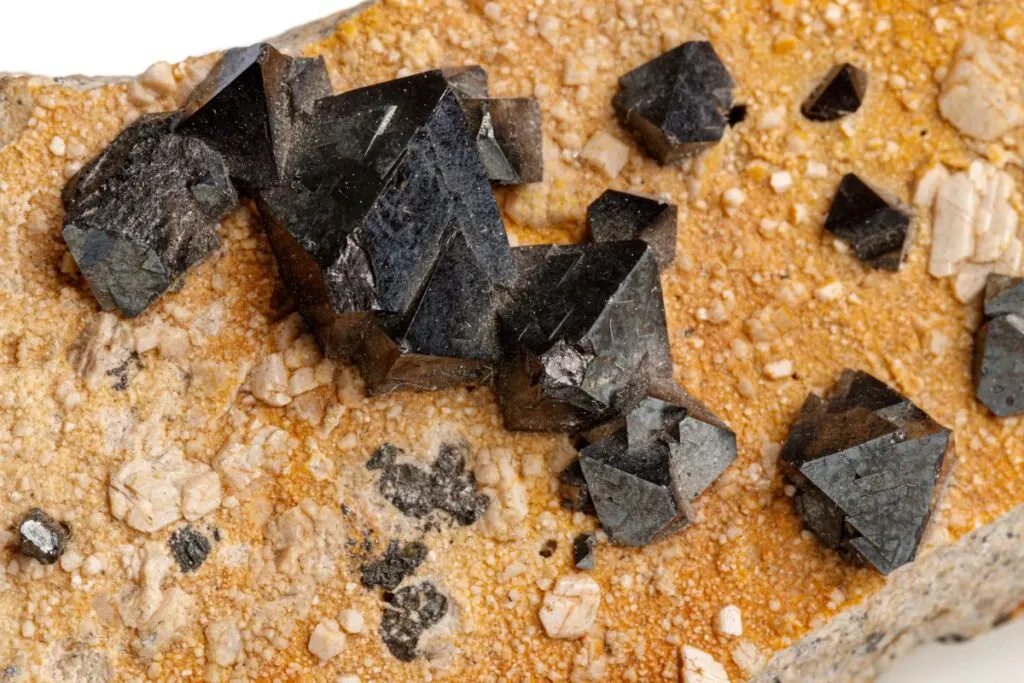As an Amazon Associate, I earn from qualifying purchases with no additional costs for you.
Some minerals and rocks have pretty unique magnetic properties. Magnetism in minerals is crucial for ore geologists specializing in iron deposits and for paleontologists making reconstructions and evolution of planets and meteorites. However, magnetic properties can also surprise you while checking your mineral collection.
Minerals like magnetite, pyrrhotite, ilmenite, maghemite, awaruite, and sometimes garnet, and peridot are attracted by magnets. Serpentinite and ironstone are two types of rocks of strikingly different origins that are also attracted by magnets. Iron is an agent that gives rise to magnetic properties.
Even some brilliant transparent faceted gemstones can be attracted by a magnet, not only opaque minerals with an evident metallic luster. Let’s unravel what types of stones and rocks are susceptible to magnets. What is the reason for magnetism? And why some rocks are more magnetic, and others are inert. Who, as a child, didn’t play with a magnet? Let’s bring this childish game to another level today!

If you are interested in checking out the best books about rock and minerals identification you can find them by clicking here (Amazon link).
Why Are Some Rocks Magnetic
We all played with a magnet, testing some keys, spoons, coins, and even the polished surface of daddy’s car for magnetic properties. Surprisingly, some minerals and rocks can also be attracted by a magnet.
Not all of them, only those that have some specific component. This component is iron! And if you found a heavy opaque rock that attracts magnets – woohoo, there is enough iron to start the mining!
Some rocks are magnetic because of the presence of iron or iron-bearing minerals. The higher the concentration of magnetite (the main magnetic mineral), the stronger the magnetic properties of the rock. Ironstone — sedimentary rock with the highest concentration of iron oxides is the most magnetic.
Before moving further, let’s define some terms. In this article, we use the word magnetic as an indicator of minerals that can be attracted by a magnet.
We describe a usual experiment with a standard magnet and a rock or a mineral. If the mineral is magnetic, it doesn’t mean that light metallic objects like pins, nails, or coins stick to it. Instead, these are minerals and rocks that attract a magnet.
The reason for such a disclaimer is that all materials have magnetic properties from a scientific point of view. For example, they can be higher, lower, or inert and are measured by far more sophisticated equipment than an ordinary magnet. So let’s get back to rocks.
The magnetic properties of rocks result from their mineral composition. The mineral composition of rocks depends on the type of rocks, geological environment, and further alteration of rocks.
Magnetite – mineral responsible for magnetic properties of rocks can be favorable for one geological process and unfavorable for others.
Almost all rocks have magnetic properties, but very few are magnetic (according to the terminology discussed above, they can attract magnets).
Various types of rocks have different amounts of iron and magnetic minerals. They can be so tiny that they are invisible to the unaided eye. But these slight magnetic inclusions will influence the overall magnetism of rocks.
BTW: Do you want to know more about rock and mineral identification? The books listed below are the best ones you can find on the internet (Amazon links):
- Smithsonian Handbooks: Rocks & Minerals
- Gemstone & Crystal Properties (Quick Study Home)
- Ultimate Explorer Field Guide: Rocks and Minerals (National Geographic Kids)
What Does It Mean When Rocks Are Magnetic
Magnetic rocks are indicators of elevated iron concentration. You can take a loup and figure out what kind of mineral gives rise to magnetic properties. We are pretty sure that you will see opaque black tiny crystals.
If the rock is magnetic (can be attracted by a magnet), it means it has elevated concentrations of magnetic minerals, such as magnetite, pyrrhotite, or ilmenite. These minerals react to magnets giving the rock magnetic properties. Examples of magnetic rocks are ironstone and serpentinite.
The magnetic properties of rocks and minerals are valuable for different kinds of ore beneficiation. Suppose ore geologists are looking for iron, and this is the most precious element for them.
But the opposite, the ores for the glass and ceramics industry are unfavorable to magnetic minerals. Therefore, various stages of magnetic separation took place to clean glass sand (for example) from magnetic minerals that lower the quality of the final product.
TIP: Have you ever thought about using a metal detector for finding magnetic rocks? Find out the complete guide in the article below:
How to Actually Find Gems with a Metal Detector? It’s Easy!
What Material Makes Magnetic Rocks Magnetic

Iron-bearing minerals and their amount are responsible for rocks’ magnetic properties. In addition, different minerals have various amounts of iron in their composition, also creating a difference in resulting magnetic properties.
Magnetite, pyrrhotite, and ilmenite are minerals that make magnetic rocks magnetic. However, if we go deeper – iron is a chemical element that builds up these minerals and, as a result, gives rise to magnetic properties of rocks that contain these three main magnetic minerals.
Minerals have different magnetic properties and can be subdivided into the following groups:
- Weakly magnetic minerals (unnoticeable reaction with a common hand magnet)
- Non-iron-bearing minerals (calcite, gypsum, quartz)
- Iron-bearing paramagnetic minerals (biotite, garnet, olivine)
- Strongly magnetic minerals (can attract a magnet)
- Iron-titanium oxides (titanomagnetite magnetite, ulvöspinel)
- Iron sulfides (pyrrhotite)
- Iron alloys (materials found in meteorites).
Minerals that do not have iron (non-iron-bearing minerals) and thus have no magnetism are called diamagnetic. The most widespread diamagnetic minerals are quartz, plagioclase, calcite, gypsum, and apatite.
Paramagnetic minerals may be weakly magnetic and can be separated by their various degrees of magnetic susceptibility.
Paramagnetic minerals only show magnetic properties when subjected to an external magnetic field. When the magnetic field is removed, the minerals have no magnetism. Such minerals as garnets and olivines are one of the most common examples.
Ferromagnetic minerals have permanent magnetism. These materials will become magnetized when placed in a magnetic field (magnet).
They will remain magnetic after the external field is removed. Examples of such minerals are magnetite, hematite-ilmenite solid solutions (Fe2O3 – FeTiO3), and pyrrhotite (Fe1-xS).
Magnetite (Fe3O4) is a unique representative of ferrimagnetic minerals. Ferri, not ferro. Lodestone as a variety of magnetite is the only mineral that works like a natural magnet and can attract light metallic objects like pins, and nails.
Do All Rocks Have Magnetic Properties
All rocks have magnetic properties of different values. Still, not all rocks have such strong magnetic properties to attract or to be attracted by a hand magnet.
For example, a quartz pebble in the yard will stay inert to a magnet. Light-colored rocks and minerals are also so weekly magnetic that they stay unsusceptible to magnets.
All rocks have magnetic properties. Rocks can be highly magnetic or diamagnetic, which means they are not attracted by magnets. There are different levels of magnetic susceptibility of rocks. Highly magnetic rocks are ironstone and serpentinite – rocks that are highly enriched in magnetite minerals.
Magnetic properties of rocks form at the earliest stages of rock formation. As magma or lava cools, magnetic minerals begin to form.
When the molten rock has not solidified completely, the magnetic minerals float in the molten mass and become aligned to the planet’s magnetic field. After the rock crystallizes, it preserves the alignment of tiny magnetic mineral compasses.
This alignment is essential for paleomagnetic studies and is a powerful tool for reconstructing plate tectonics and the movement of continents over time and helps reveal the geologic history of planets, moons, and asteroids.
A similar approach works for sedimentary rocks. An orientation of tiny rounded magnetite grains occurs during the long-time sedimentation process in the water environment.
TIP: Mineral properties are very specific characteristics of every separate mineral. Check out the complete about all rock and mineral properties in the article below:
Guide: All Rock & Mineral Properties Explained by Expert
What Types of Rocks and Minerals Are Magnetic
There is a general rule that dark-colored rocks and minerals tend to have more magnetic minerals and more iron. Strongly magnetic minerals are primarily black and opaque and with a strong metallic luster.
All three types of rocks can be magnetic depending on the amount of iron present. The most magnetic rocks are iron ores – sedimentary or metamorphic origin rocks that attract magnets easily. Serpentinites are magnetic metamorphic rocks. Igneous rocks of basic composition can also be slightly magnetic.
Most rock-forming minerals exhibit very low magnetic susceptibility. We already know that such ubiquitous rock-forming minerals as quartz and plagioclase are diamagnetics. The reason rocks are magnetic is the proportion of magnetic minerals like magnetite or ilmenite they contain.
Are Volcanic Rocks Magnetic
There are volcanic rocks (rocks that quickly solidified on the surface out of lava) of different chemical compositions and, as a result, have a different amount of iron that directly influences further magnetic properties of rocks.
Volcanic rocks‘ of basic and ultrabasic composition (komatiites and basals) magnetic properties of rocks are rarely so intense to attract magnets. Therefore, they can be measured by laboratory equipment only. In addition, volcanic rocks are rarely iron-rich to interact with a hand magnet.
Volcanic rocks differ from igneous by the level of crystallization. As they crystallize rapidly on a surface, minerals don’t have enough time to create macroscopical crystals with even crystal faces.
The chemical composition is the same as for igneous rocks, but the crystals’ size doesn’t. That is why the magnetic properties of volcanic rocks are not so strikingly different from their igneous analogs.
Are Igneous Rocks Magnetic
The same approach with igneous rocks. There are also different rock-forming environments, the composition of the magma, and, as a result, different concentrations of iron responsible for magnetic properties.
Igneous rocks are commonly more magnetic than sedimentary rocks. There is also a subdivision of magnetic properties inside igneous rock groups based on composition. Mafic igneous rocks (gabbro or peridotite) have more magnetic minerals than felsic. Igneous rocks are not so magnetic to be attracted by magnets.
Basic igneous rocks (e.g., gabbro) have a relatively high magnetite content. They are rocks with high magnetic properties (it doesn’t mean a magnet can stick to them). The proportion of magnetite in igneous rocks decreases with increasing acidity (increasing SiO2 content).
Acidic igneous rocks (e.g. granites) are composed mainly of quartz and feldspars without any magnetic minerals, so their magnetic properties are usually lower than those of basic rocks.
TIP: Quartz is the most common mineral on earth, and the minerals in the feldspar group make up almost 60% of the earth’s crust. Check out the differences between quartz and feldspar in the article below:
Feldspar vs. Quartz: What’s the Difference? 5 Crucial Signs
List of Common Magnetic Rocks and Minerals

Magnetic minerals are ubiquitous minerals that can be found in all types of rocks. But the reason why not all types of rock can attract magnets is hidden in the concentration of magnetic minerals. So how do recognize magnetic minerals, and what are their unique features?
Magnetite, pyrrhotite, and ilmenite are three main minerals that can attract a magnet. Some garnets – highly ferrous almandine, peridot, and dark-colored spinels can be attracted by a magnet. Ironstone – and iron ore, and serpentinites are examples of magnetic rocks because of the magnetite they contain.
There are three main minerals responsible for the magnetic properties of rocks. They are magnetite, ilmenite, and pyrrhotite. In addition, some very exotic minerals like magnetoplumbite, awaruite, and tetraferroplatinum are also noticeably magnetic.
- Magnetite
Magnetite (Fe2O3) is a ferrimagnetic mineral with the highest iron content (72.4%). Naturally magnetized variety of magnetite lodestone can be a magnet itself.
It is commonly found with iron-bearing minerals stuck to it. A lodestone doesn’t discharge because of an inhomogeneous crystalline structure that lets a lodestone be a natural permanent magnet.
Magnetite occurs in all types of rocks. It can be primarily magmatic. Be present in sedimentary rocks as tiny rounded grains. By the way, black grains in beach sand are usually magnetite.
Test them with a magnet next time. Magnetite is also commonly present in metamorphic rocks. See the rock cycle to learn more.
Being present in all types of rocks, magnetite gives rise to the magnetic properties of rocks. The magnetite concentration is responsible for whether the rock will be magnetic or not.
Magnetite is an opaque black mineral with a metallic luster. It crystallizes in an isometric crystal system and commonly occurs in octahedrons.
- Pyrrhotite
Pyrrhotite is the second most common magnetic mineral. It is an iron sulfide mineral found in igneous and metamorphic rocks.
Its Fe(1-x)S chemical formula indicates that it is deficient in iron – which causes pyrrhotite to be slightly too strongly magnetic. Pyrrhotite is lighter than magnetite in color. It is bronze or dark brown and softer than magnetite.
- Ilmenite
Ilmenite (Fe,Ti)2O3 is a black opaque accessory mineral that occurs in a wide range of igneous and metamorphic rocks, especially gabbroic varieties. Also, it is found in sediments due to its resistance to weathering.
It is mainly found in the sand and silt fractions. It is also an opaque black mineral with metallic luster and similar hardness. However, ilmenite, unlike magnetite and pyrrhotine, has conchoidal fracture.
Pyrrhotine and ilmenite never occur in isometric octahedral crystals, which can be differentiated from magnetite due to that feature. These three minerals above are responsible for the magnetic properties of rocks.
Rocks
The highly magnetic rock is ironstone or iron ore, a sedimentary rock sandstone mostly with high magnetite content.
Another highly magnetic rock is serpentinite – a green-colored metamorphic rock with a high concentration of magnetic minerals.
Gemstones
Gemstones like garnet Fe3Al2(SiO4)3 (almandine) and peridot (Mg,Fe)2SiO4 (olivine), can also respond to strong magnets (like a neodymium magnet). All three minerals have iron as a structural component in their crystal lattice. But be careful while testing! Don’t scratch or chip your gemstone with a magnet.
TIP: Choosing rocks of the same family is very important in tumbling. Check out what rocks can be tumbled together in the article below:
What Rocks Can Be Tumbled Together: Complete List With Tips
FAQs About Magnetic Rocks
Still did not find the answer to your questions about magnetic minerals? Find frequently asked questions in the section below:
Are Magnetic Rocks Meteorites?
Some highly ferrous meteorites (iron meteorites) can attract magnets. But not all meteorites are magnetic enough to interact with a magnet. Only iron meteorites are magnetic enough for magnets to stick. So there are some additional tests needed to identify meteorites.
Are Magnetic Rocks Rare?
Magnetic rocks are not rare. For example, the Banded iron formation (the most significant source the iron extracted from) can extend laterally for several hundred kilometers and is reported in Australia, Brazil, Canada, South Africa, Ukraine, and the United States.
How Many Rocks Are Magnetic?
Three main minerals (magnetite, pyrrhotite, and ilmenite) are strongly attracted to a magnet. Two types of rock – serpentine and ironstone are almost always magnetic. Some gemstones like dark-red garnet and peridot (olivine) can also be magnetic.
Conclusion
The magnetic properties of rocks arise from the magnetic properties of the constituent mineral grains and crystals. The main three minerals that create magnetic properties are:
- magnetite
- pyrrhotite and
- ilmenite.
All these minerals have one common feature – a big percentage of iron in their composition. Iron – is a chemical element that gives rise to the magnetic properties of minerals and, as a result, the magnetism of rocks.
The more magnetite, ilmenite, or pyrrhotite rock has in its composition, the higher the magnetic properties are. All rocks have magnetic properties, but the number of magnetic minerals differs in various rock types.
For example, sandstone with an elevated amount of magnetite can be iron ore and even attract a magnet. Serpentinite – metamorphic rock that also contains a high amount of magnetite inclusions and is highly magnetic.
Gemstones like dark-red highly ferrous garnet (almandine), peridot (olivine), and black spinel are weakly magnetic minerals but sometimes can be attracted to strong magnets.
TIP: Everybody wants to know if a mineral they found during rock hunting or bought at a mineral show are magnetic or has any other interesting properties. Check out the complete guide in the article below:
Easy Step-by-Step Mineral Identification (Expert Explains)
